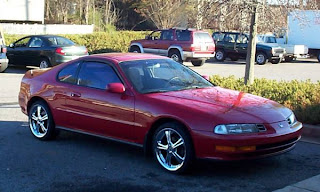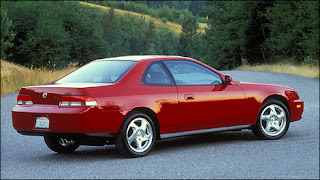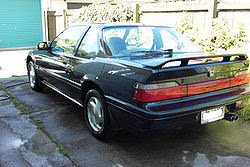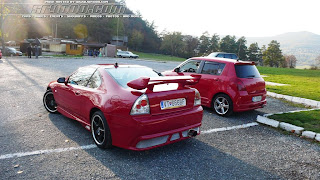Introduced in 1979, the Honda Prelude was the company's first attempt at building an exciting car that still held true to the core Honda values of intelligent design and reliability. Over the next two decades, the two-door sport coupe would become the primary performance car in the Honda lineup. Although it was outfitted with relatively powerful engines in later generations, the Prelude was not a muscle car. It was built around handling and drivability, while providing enough power to remain competitive.
Honda Prelude Review
Over its life, several new technologies for Honda were pioneered on the Prelude, such as fuel injection, four-wheel steering and Honda's Active Torque Transfer System. The Prelude was also the first Honda model to get VTEC, the company's variable valve timing engine technology.
Honda Prelude Review
Though the Honda Prelude was very popular throughout the '80s, consumer interest waned in the '90s. Eventually, the Prelude was trapped in an under-$30,000 no-man's land. For a sporty front-wheel-drive coupe, it was just too pricey, and it didn't have sports car looks or a sufficiently premium feel. By the turn of the millennium, the sport coupe market was a shadow of its former self. Honda dropped the Prelude without a replacement after the 2001 model year. As a pre-owned option, however, the rewarding and reliable Prelude merits serious consideration from driving enthusiasts on a budget.Most Recent Honda Prelude
If you're searching for a used Honda Prelude, you'll likely be encountering the fifth and final generation, which was sold from 1997-2001. It was larger and heavier than any of the previous models. It was also the most dynamic. There were two trim levels: base and Type SH. Both got a 2.2-liter four-cylinder engine with VTEC and a standard five-speed manual transmission. A four-speed automatic was available as an option on the base model. Initially, the engine put out 195 horsepower, but in 1999, Honda bumped maximum power up to 200 hp in the manual-transmission models.
Honda Prelude Review
Both trims were equipped with a generous array of standard features that included 16-inch alloy wheels, ABS, cruise control, a sunroof, air-conditioning and full power accessories. The main difference between the base model and the Type SH was the addition of Honda's Active Torque Transfer System, an electronic system that distributed torque to the outside drive wheel in cornering situations. Its purpose was to minimize understeer and thus mimic rear-wheel-drive cornering characteristics.
Honda Prelude Review
In road and comparison tests, our editors found the Honda Prelude Type SH to be one of the best-handling cars in its class -- truly a driver's car. It was nimble and well balanced, while also maintaining a decent amount of ride comfort. There was just enough engine performance to be sporty, with the VTEC four performing a Jekyll-and-Hyde transformation in feel and sound above 5,200 rpm. Zero-to-60 times were in the low 7s. In 1999, the Prelude won Edmunds.com's Editors' Most Wanted award for Best Sport Coupe ($10,000-$25,000). In 2000, it won again for Best Sport Coupe.
Honda Prelude Review
Despite being a great-performing car, the Honda Prelude was lacking in other areas. The interior boasted high-quality materials and construction, but it lacked the visual pizzazz buyers had come to expect from a car with a $26,000 price tag. Honda maintained a conservative approach here, filling the cabin with a monochromatic color scheme and Accord-like gauges and controls. The front seats, though comfortable, weren't available in leather and had limited adjustability. The rear seats had minimal legroom. The fifth-generation Prelude has aged well, however, as that restrained interior design now seems classier and less dated than brash designs like the contemporary Toyota Celica.
Honda Prelude Review
Past Honda Preludes
The other Honda Prelude one should consider is the fourth-generation model, which was sold for the 1992-'96 model years. A complete overhaul of the previous model, this Prelude was slightly shorter, much wider and a far better-handling car. The S trim featured a 135-hp 2.2-liter SOHC four-cylinder. The Si had a 160-hp 2.3-liter DOHC four-cylinder with a healthy 156 pound-feet of torque. From 1993 on, the fourth-generation Prelude could also be had in range-topping Si VTEC trim, which brought a 2.2-liter 190-hp DOHC four equipped with Honda's electronic variable valve timing (VTEC) system. A four-wheel-steering system was available in 1992-'93, though only on the Si model.
Honda Prelude Review
In general, the fourth-generation Prelude earned favorable commentary in reviews at the time. It offered excellent handling, and nearly all who drove it liked the power of the VTEC-equipped engine. Criticisms were mostly directed at the car's odd interior design. A sweeping blacked-out instrument cluster extended across the entire dash, and few found the mix of analog and digital gauges appealing.Honda Prelude History
Honda established itself in America with the Civic and Accord ? both good, solid but basic cars. But big profits in the automotive world don't come from basic cars that sell for commodity prices. Those profits come from cars that get consumers so excited that they'll pay a premium price just to have one. The Prelude was Honda's first attempt at an exciting car.
The Prelude was Honda's technological leading edge. Features that are now expected from Honda, like the double-wishbone suspension under the Accord, fuel injection, and VTEC electronic variable valve timing system showed up first on the Prelude before migrating across the Honda line (though VTEC first showed up on the 1990 Acura NSX). The Prelude was also a test bed for some technologies that went nowhere, like four-wheel steering.
When it debuted in 1979 the Prelude wasn't much more than an Accord with all the pesky utility removed. By the time it left production 22 years later, it was, arguably, the finest handling front-drive car ever built and home to one of the world's great four-cylinder engines.
First Generation: 1979-1982
Let's be blunt: the 1979 Prelude wasn't exactly handsome. With its high beltline and stubby proportions, it gave no hint to the sleek sport coupe it would become in later years.
Built atop a 91.3-inch wheelbase (2.4 inches shorter than the '79 Accord), the first Prelude's chopped notchback body left little room for actual human accommodations. The front bucket seats were OK, but the rear seats were a joke ? and not a very funny one. Beyond that, the dash was an eccentric mishmash that included radio knobs that protruded out the side of the instrument binnacle and a weird combination tachometer and speedometer where both instrument's needles swept along the same arc.
Honda's designers indulged themselves with the first Prelude and it showed. But the first Prelude did have two big advantages: It was the most muscular Honda and it was, after all, a Honda.
Honda Prelude Review
The Prelude's sole power plant was a 1,751cc version of the Accord's CVCC SOHC four producing 72 hp at 4,500 rpm and 94 pound-feet of torque at 3,000 rpm, backed by either the Hondamatic two-speed automatic or a five-speed manual transmission. That sounds pathetic today, but back then the Prelude was peppy compared to some of the competition ? Motor Trend measured an early Prelude completing the quarter-mile in 18.8 seconds at 70 mph.Riding atop P175/70SR13 Bridgestone radials, the Prelude was the most generously shod Honda and the all-independent suspension provided both good grip and an excellent ride. "It is," wrote Brock Yates for Motor Trend, "by any sane measurement, a splendid automobile. I know; I own one. The machine, like all Hondas, embodies fabrication that is, in my opinion, surpassed only by the narrowest of margins by Mercedes-Benz. It is a relatively powerful little automobile by anybody's standards. (Can one imagine the ecstatic yelping if Porsche produced a 1.7-liter OHC capable of 100 mph for $7,000?)" Yet Road & Track fretted openly that "...we just can't get past the car's styling and basic layout." Car and Driver whined about the car's instrumentation, murkily observing, "Honda management obviously concluded that the difference between a sporty car and a sedan is gadgetry." The pundits at our sister publication Sports Car Graphic joined in the widespread denouncement of the Prelude's interior ? especially its miniscule rear seat; "...being inside the Prelude borders on claustrophobia," was the semantic sideswipe they chose to describe the confines of the car.
Honda Prelude Review
Honda replaced the Hondamatic with a three-speed automatic for 1980 and added some electronic warning bells for 1982, but otherwise the first-generation Prelude remained very much the same car throughout its production life.
The first Prelude had its hard-core fans, but the next Prelude would impress everyone.
Second Generation: 1983-1987
The second Prelude was nearly perfect. From bumper to bumper and side mirror to side mirror, every detail of the 1983 Prelude's engineering made perfect sense.
"The '83 Prelude is longer, wider, quicker, faster, and far prettier than its immediate and only predecessor, with entirely new suspension systems front and rear, a brand-new engine, new cabin appointments and a slick styling job that reflects its new drag coefficient of 0.36," wrote Motor Trend on the car's introduction.
Sharing the Accord's 96-inch wheelbase, the '83 Prelude had a full 100 hp (at 5,500 rpm) at its disposal due to the new 1,829cc SOHC 12-valve four with a head cast from an aluminum and titanium alloy inhaling through twin 34mm Keihn carbs.
Honda Prelude Review
The additional power was great, but the most significant development on the new Prelude was the suspension. "The low nose is the key to the new front suspension," Motor Trend explained. "Honda designers left no room for conventional MacPherson struts, so the final car has a most unconventional upper and lower arm layout. The lower arm leads, and carries a coil/shock unit mounted directly to the body on top and straddling the half-shafts to connect to the lower arm. The upper arm mounts to the car behind the top strut mount and is ball-jointed to the upright. The forged upright passes very close to the inner tire/wheel surface, and is twisted forward and down to join the hub/brake assembly.... According to Honda suspension designers, the system is short, light, compact and capable. With upper and lower arms, the wheel has zero caster in the straight-ahead position, for lighter manual steering, solid feel and quick response. In cornering or braking, the deflection in the upper pivot causes increased caster, while the tires remain upright through the corner."That basic front suspension design (called "double wishbone") quickly became a Honda hallmark and it's still used on current Accords as well as Acura's TSX and TL. The '83 Prelude's rear suspension, on the other hand, used long, stamped transverse arms and more conventional MacPherson struts.
More than two decades later, the '83 Prelude is still handsome. With its low beltline, large greenhouse and crisp lines, it still looks contemporary. And inside, its no-nonsense interior only looks dated in some details like the ventilation controls. Clearly, the second-generation Prelude was a car well ahead of its time.
Honda Prelude Review
In a three-way comparison test pitting the '83 Prelude against the Dodge Shelby Charger and Volkswagen Scirocco, Motor Trend concluded "for our money, the most appealing car here is Honda's new Prelude. Not only does it deliver most of the Shelby Charger's maximum performance and all of the Volkswagen's quality and refinement, and more technical innovation than the other two combined, it is also just so incredibly nice. There are no real flaws in it anywhere. From the conception of its engine and suspension right down to the treatment of the tiniest detail, careful and thorough thinking shows through. The engineering that has gone into it has a positive and immediately evident effect."
Rear disc brakes came aboard to match the front pair on the 1984 Prelude, but other changes were scant. Midway through the 1985 model year the Prelude Si appeared featuring fuel injection atop a 2.0-liter version of the regular Prelude's engine. The Si also got a so-very-'80s monochromatic exterior that included spoilers both fore and aft, and an interior stuffed with luxury equipment like power windows, cruise control and a sound system with a graphic equalizer to ensure that the driver's Depeche Mode cassette sounded totally rad.
Honda Prelude Review
The Prelude and Prelude Si continued through the 1986 and 1987 model years essentially unchanged. The second-generation Prelude set the tone for much of what Honda would produce for the next two decades. In most ways it was the first modern Honda.Third Generation: 1988-1991
"What do you do with a car that leads the field in total performance and offers great comfort and convenience to boot?" asked Motor Trend somewhat disingenuously about the 1988 Prelude Si amid its seven-coupe comparison test. "You place it high on the charts, that's what you do, and that's what we've done with the Prelude Si.
"Newly designed for '88, the Prelude delivers handling that's superior even amidst this stellar field. This is truly an aim-it-where-you-want-it car. The steering is effortless, the double-wishbone front and rear suspension willing and incredibly precise. Though not equipped with antilock brakes, the Prelude still led in braking on the strength of superb balance between its front and rear discs."
Honda didn't mess much with the second-generation Prelude's successful formula when it was designed the third. The proportions of the car were similar (the wheelbase grew 3.3 inches to 101 inches and the overall length grew from 169.1 inches to 175.6) and the updated looks strictly evolutionary revisions. Under the skin, however, the chassis was updated with double wishbones now suspending each corner and two new 2.0-liter four-cylinder engines. The base Prelude "S" ran with a twin-carbureted SOHC, 12-valve version of the new 2.0-liter power plant rated at 104 hp at 5,800 rpm while the Prelude Si's fuel-injected, DOHC, 16-valver made a full 135 hp at a whirring 6,200 rpm. At the time, that was the most powerful engine Honda had ever put into a production road car.
Honda Prelude Review
But the Si wasn't at the top of the Prelude line any more as the Prelude Si 4WS took that position. "4WS" of course meant that four-wheel steering was aboard, and the 4WS did carry a mechanical four-wheel steering system in which the rear wheels would move slightly (counter to the front wheels at parking lot speeds) to improve maneuverability. At $17,945 the 4WS was $1,300 more than a regular Si which was plenty maneuverable enough for most buyers. The 4WS model would persist into the fourth-generation Prelude, but buyers did a good job of ignoring it.Carrying through 1989 essentially unchanged, the Prelude got a small tweak to its appearance for 1990. But more importantly Honda also planted a new 2.1-liter, all-aluminum, 140-hp, DOHC, 16-valve engine in the nose of the Si. It also treated the base Prelude S to fuel injection, and that engine produced either 104 or 105 hp depending on whether a five-speed manual or four-speed automatic transmission was ordered.
The third-generation Prelude was a worthwhile extension of what the second generation had established. The fourth-generation Prelude would be more than an extension...it would be an expansion.
Fourth Generation: 1992-1996
The fourth-generation Prelude didn't look like previous Preludes with its sharklike nose and a sloping roof that swept into the trunk area semi-fastback style. Compared to the third-generation car, the fourth was not quite as long overall (down 0.8 inch to 174.8), slightly shorter (down 0.2 inch to 50.8), and rode on a just barely shortened wheelbase (down 0.6 inch to 100.4). But it was significantly wider (up 2.2 inches to 69.5) and combined with Honda's excellent four-wheel double-wishbone suspension that made for a much better handling machine. The 4WS model was back, too, (for no apparent reason) and now used an electronic four-wheel steering system instead of the mechanical one.
Honda Prelude Review
Honda Prelude Review
The best news for 1992 though was the engine lineup. The base Prelude S now had a robust 2,156cc SOHC, 16-valve four pumping out 135 hp at 5,200 rpm (the same as the '88 Prelude Si), the Si's 2,259cc, DOHC, 16-valve four could be counted on for an impressive 160 hp at 5,800 rpm. And there was more to come.
Sure the '92 Prelude was good. But the 1993 edition was so much better with the addition of a new range-topping VTEC model. Using a 2,157cc DOHC, 16-valve four equipped with Honda's electronic variable valve timing system, the new engine roared all the way to 190 hp.
VTEC is Honda's acronym for Valve Timing and Lift Electronic Control, which it once explained in context of the '93 Prelude thusly: "At engine speeds below 4,800 rpm the valves are actuated by low-rpm cam lobes to maximize low-end torque and efficiency. At about 4,800 rpm (depending on throttle position) an electronic control unit signals a spool valve to open, sending engine oil to small pistons in the rocker arms. The pistons lock the arms to a third rocker arm follower that's actuated by a high-speed cam lobe. The valves then follow intake and exhaust timing and lift more closely optimized for high-rpm output." So effective was the system that Motor Trend measured a Prelude VTEC ripping to 60 mph in just 7.2 seconds.
Honda Prelude Review
"The Honda Prelude is the world's best handling front-drive car," wrote Car Craft, a magazine that traditionally scorns anything that isn't a Camaro. "Its new top-of-the-line 190-hp, DOHC, 16-valve, electronically controlled variable valve timing VTEC 2.2-liter engine is the world's best normally aspirated four-cylinder engine. Driving the VTEC is like watching Robin Williams bounce from one character to another in the middle of a sentence; you know it's happened, but you're stunned he's able to do it."
The VTEC had the headlines, but the overall excellence of the Si earned it some praise as well. In comparison with the V6-powered Mazda MX-6, Motor Trend wrote that the '93 Si "with a dual-stage induction system and two balance shafts to dampen secondary vibrations in the mid- to upper-mid power range...was applauded for its smoothness and razor-sharp response. In fact, despite real-world numbers, its strong snap often makes it feel peppier and more immediate than the MX-6. However, during acceleration and at high rpm, it's a bit louder than the Mazda as well."
Honda Prelude Review
Reviewers all loved the engines, but the fourth-generation Prelude did come in for some criticism. "Styling is subjective" wrote Motor Trend, "and while some liked the Prelude's beefy angularity, others found the large triangular taillamps and ample rear bumper disturbingly disproportionate." Car Craft added that the "nose has already been copied for the Eagle Vision. The rear reeks of Oldsmobile and is the most controversial element."
While there were some out there who defended the fourth-generation Prelude's exterior appearance, no one would stand up for the interior design. Motor Trend wrote that "the most prominent feature is the blacked-out instrument cluster that extends across the entire dash. With the ignition off, all that's visible is a conventional analog speedometer and tach in front of the driver. Switching on the key activates digital fuel and coolant temperature gauges, a string of warning lights and a digital clock." Car Craft was more blunt: "The interior is an adventure in dorkiness.... The rear seat is useless to any mammal that has proceeded beyond embryonic, the dash is a silly mix of electronic and analog gauges and there's practically no storage room or conveniences. As the wife of our art director exclaimed while looking at the panel for the passenger side airbag 'Forget the airbag, I want a cupholder!'"
Honda Prelude Review
For 1994 all Preludes featured dual airbags and the 4WS version was finally excised from the lineup before the 1995 model year, but that was it for the fourth Prelude which lived through 1996 unchanged.
Fifth Generation: 1997-2002
The last Prelude was the largest, the heaviest and, many would claim, the best. However it was also the most expensive and it appeared as the market for coupes in America was disappearing and the market for SUVs was rising.
Tossing aside the knife-edge styling of the fourth generation, Honda's fifth-generation Prelude revived themes established by the second- and third-generation models. It was a handsome car with the only controversial element being headlights that wrapped up and over into the front fenders.
At 178 inches long over a 101.8-inch wheelbase, and 69 inches wide, the fifth-generation Prelude was basically as long as the third-generation Prelude and as wide as the fourth. Mechanically the car was very much a carryover from the fourth generation with a double-wishbone suspension at each corner.
All Preludes were now VTECs and modest revisions to the existing VTEC engine pumped output of the 2,157cc engine from 190 to 195 hp. Both the base Prelude (no longer an "S") and the new "Type SH" used the same engine with either the five-speed manual transmission or the four-speed automatic. The automatic was also available with Honda's sequential SportShift electronic transmission.
Honda Prelude Review
The 1997 Prelude SH also got Honda's Active Torque Transfer System (ATTS) which used computer-controlled clutches to distribute torque to the outside drive wheel during cornering. While the ATTS system gave the Type SH an advantage in stability over the regular Prelude, the regular Prelude had a lighter, more tossable feel. But the new car's heft showed up at the drag strip, where the five extra horsepower of the latest Prelude was consumed by the weight. The 7.2-second 0-to-60-mph time measured by Motor Trend was unchanged from the fourth generation.
After a carryover 1998, the 1999 Prelude appeared with a full 200 hp for manual transmission models (automatics continued to be rated at 195 hp). If there were any changes to the 2000 Prelude, even Honda wasn't talking about them.
Even though it was obvious that the Prelude was doomed by the 2001 model year, Edmunds.com included a Type SH in our 2001-2002 Sport Coupe Comparison Test. It finished 4th of six, but it was a strong 4th!
"With most front-drive cars, applying too much throttle too quickly when exiting a corner unloads the front suspension and causes the car to understeer," wrote Brent Romans in explaining the Prelude's performance. "Enter ATTS. Hit the gas past the apex of a corner and the Prelude simply pulls itself around. Being able to accelerate through turns pays big dividends, as this allows the Prelude to carry more speed on the straights. It also gives the car a much more neutral handling bias, and our editors said that driving the Prelude almost felt like driving a rear-wheel-drive car. Despite having a curb weight and horsepower rating similar to the Eclipse (not to mention 49 lb-ft of torque less), the Prelude was more than 2 seconds faster per lap. Its fastest lap, a 1:26.0, was the second-quickest lap time of any of the front-drivers."
Honda Prelude Review
Honda Prelude Review
Honda Prelude Review
Honda Prelude Review
Honda Prelude Review
Honda Prelude Review
Honda Prelude Review
Honda Prelude Review
Honda Prelude Review
Honda Prelude Review
Honda Prelude Review
Honda Prelude Review
Honda Prelude Review
Honda Prelude Review
Honda Prelude Review
Honda Prelude Review
Honda Prelude Review
But ultimately it finished 4th for a reason. "Overall, the Prelude is an outstanding sport coupe that provides comfort, sportiness, superior build quality and a reputation for excellent reliability," Romans enthused. "The only thing missing is value. With a price over $26 grand, the Prelude is the most expensive car of the six. Here are some tips: 1) ATTS is nice, but if you're not going to a racetrack anytime soon, just go with the regular Prelude. 2) If you're buying around the end of calendar-year 2001, you should be able to get a good deal on a Prelude, as dealers will be looking to offload them. 3) No 2001s? No problem. The Prelude hasn't changed much since 1997. Find a used Prelude in good condition, save a bundle of cash. Any of these options will get you a great car."
courtsey by:http://www.edmunds.com/honda/prelude/history.html
courtsey by:http://www.edmunds.com/honda/prelude/

































